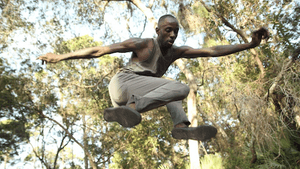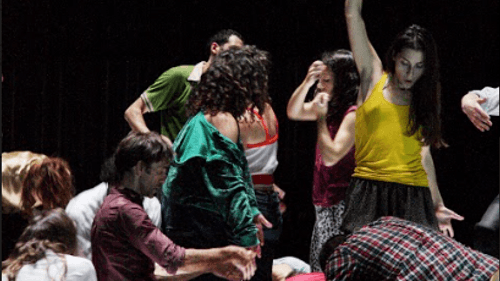Stay in the Loop
BSR publishes on a weekly schedule, with an email newsletter every Wednesday and Thursday morning. There’s no paywall, and subscribing is always free.
Sweat and repetition
Philly Fringe 2016 review: Reggie Wilson's 'CITIZEN'/Boris Charmatz's 'Levee des Conflits'

It is draining and at times frustrating to watch a dance company repeat a movement phrase for long stretches of time. But what tests the patience is also what makes CITIZEN and Levée des Conflits — the latest works by renowned choreographers Reggie Wilson and Boris Charmatz, respectively — mesmerizing and fascinating.
FringeArts invited Wilson and Charmatz to be a part of the 2016 Philadelphia Fringe Festival as part of their Fringe Curated series. CITIZEN and Levée des Conflits yield two very different nights of dance, but Wilson and Charmatz examine the same themes of identity and incorporate similar aesthetics.
Who are you?
Wilson and his Brooklyn-based company, Fist and Heel Performance Group, tap into what has become one of the most heated topics of the 2016 presidential election: citizenship. But for Wilson, the investigation of what it means to be a citizen goes beyond the notion of home. Questions like “what does it mean to belong?” and “what does it mean to not want to belong?” became Wilson’s framing device for Fist and Heel’s newest endeavor.
In a series of tag-team solos, each dancer enters as the other finishes. However, they never acknowledge the other’s presence. The only eye contact is directed towards the audience (if they look at anyone at all). But just as quickly as a dancer stops for a confronting stare, they’re on the move again, flinging across the stage with a combination of fury in the body and eerie stoicism in their expressions. Their faces remain unchanging even as their bodies go from skittering feet and stomping to stark stillness, eyes gazing upwards, fingers rippling like waves.
The dancers are never truly alone on stage. In a collaboration with cinematographer Aitor Mendilibar, videos of the soloists are projected onto hanging white screens surrounding the stage, or lighting designed by Christopher Kuhl casts shadows on the screens, creating pas de deux in a piece that otherwise eschews them.
Even when the five dancers perform the same choreography inspired by the African diaspora at the same time, the sense of the individual lingers. They are just a group of people who happen to be doing a set of movements. Together they create a picture, yet they are determined to stand alone within it.
CITIZEN is not subtle, with its costumes of clashing black and white patterns and projections of a portrait of Jean-Baptiste Louis, the first black deputy to be elected to the French National Convention. However, in-your-face design elements fuse with the oft repeated and bracing choreography, showcasing the athleticism and stamina of the dancers and Wilson’s vision.
Does neutrality exist?
The visuals and atmosphere for Boris Charmatz’s Levée des Conflits could not be more different from those of CITIZEN (i.e. lounging in an air conditioned theatre versus sweating it out in Drexel University’s muggy armory). Folding chairs and a second row of stools surround a square dance floor taped to the ground, with the gymnasium’s overhead lighting and giant white globes reminiscent of Chinese lanterns. To an outsider, it would seem like the makings of a middle school dance.
The 24 dancers are costumed in unremarkable street clothes of various colors, patterns, and forms, and calmly stretch off to the side as the audience meander in, fans in hands. The lights fade slightly as a dancer enters the playing space to initiate the 25 repeated gestures of Levée, and we’re off.

Each dancer joins the round of movement until the space is crawling (sometimes literally) with all 24 performers. The tempo and use of space depends on the dancer beginning the sequence, which leads to a domino effect wherein subsequent performers must adjust; sometimes they have ample space to fling each other onto the floor like human bowling balls in search of pins, other times they’re clumped together as if in a mosh pit. These subtle shifts give the impression that the piece is a constantly evolving organism, merging and dividing; it’s hypnotic. And when you’re sweltering in a plastic chair for 100 minutes, the captivating nature of it all is crucial.
Charmatz, true to his roots in the non-dance movement, sees Levée as an art installation as much as a performance. The repeated movements allow spectators to see everything, regardless of where they’re seated. They can track an individual dancer or let their eyes wander. As the title (and his program notes) suggest, Charmatz is exploring “suspension of conflict,” or neutrality. However, it’s hard to see 24 dancers move, breathe, and sweat together as neutral. If anything, the marathon-like event celebrated something communal.
What, When, Where
CITIZEN. By Reggie Wilson and Fist & Heel Performance Group, Reggie Wilson choreographed. Through Sept. 10, 2016 at FringeArts, 140 N. Columbus Blvd., Philadelphia. (215) 413-1318 or fringearts.com.
Levée des Conflits. By Boris Charmatz, Boris Charmatz choreographed. Through Sept. 10, 2016 at Drexel University Armory, 33rd St. and Lancaster Ave., Philadelphia. (215) 413-1318 or fringearts.com.
Sign up for our newsletter
All of the week's new articles, all in one place. Sign up for the free weekly BSR newsletters, and don't miss a conversation.
 Alix Rosenfeld
Alix Rosenfeld